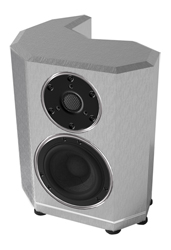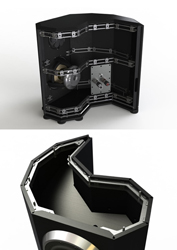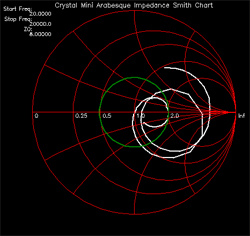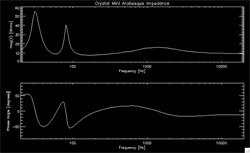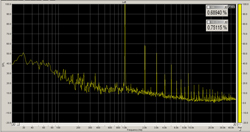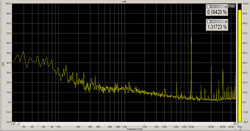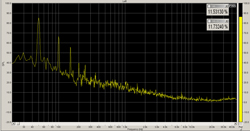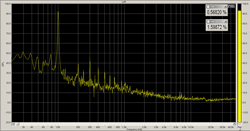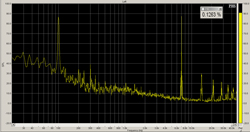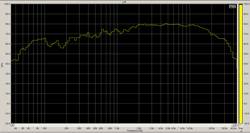Introduction to the Crystal Cable Arabesque Speakers
I first found out about Crystal Cable’s Arabesque speaker line from hifi show reports. Their Glass Master speaker cabinet is actually made from glass panels bonded together. At first this struck me as a gimmick, but then I read about how the speakers were designed. The company used the Cosmol Multi-Physics computer simulation package to design a cabinet with a minimum of resonances and optimal acoustic performance using no internal damping or baffling. Their simulations showed that a rigid, hard material like glass offered the best performance, so that’s what they used. Unfortunately, this resulted in a very expensive loudspeaker, at $65,000 a pair. Their Mini Arabesque model is a stand-mounted speaker using a similar cabinet shape, but the cabinet is made of machined aluminum. This lowers the cost to a still nosebleed-inducing price of $25,000 a pair with stands. I had a pair of these speakers in my listening room for several months to find out if this small “bookshelf” speaker could be worthy of their price tag.
CRYSTAL CABLE ARABESQUE SPEAKERS SPECIFICATIONS
- Design: Two-way, Ported
- Drivers: One 1″ Beryllium Dome Tweeter, One 4.5″ Woofer
- MFR: 45 Hz – 40 kHz, -3dB
- Crossover Frequency: 2 kHz, 2nd Order
- Efficiency: 86dB/W/m
- Nominal Impedance: 8 Ohms
- Power Handling: Max 150W RMS
- Dimensions: 12.8″ H x 14″ W x 10″ D
- Weight: 40 Pounds/each
- MSRP: $23,000/pair USD, dedicated stands $2,000 USD
- Crystal Cable
- SECRETS TAGS: Crystal, Cable, Mini, Loudspeakers, Speakers, Audio
Design of the Crystal Cable Arabesque Speakers
The first thing you’ll notice about the Arabesque Mini is the unique cabinet shape. The multi-faceted curved horn shaped enclosure footprint of the speaker is the shape it is to break up any resonant modes inside the cabinet. Standing waves can selectively reinforce or diminish sound at specific frequencies, when the cabinet dimensions are multiples of ¼ the sound’s wavelength. The shape of the Arabesque Mini cabinet is such that there are no parallel sides to the enclosure to create resonances (excepting the top and bottom panels). Furthermore, the spacing between the cabinet facets is constantly changing, which also reduces the presence of internal standing waves. The B&W Nautilus line uses similar ideas for their high frequency driver sub-enclosures, but only the limited production Nautilus model used that type of shape for the whole enclosure. The top and bottom panel resonances only come into play at frequencies below about 250 Hz.
The case itself is made from several machined aluminum panels, fastened together internally using an aluminum skeleton. Small oval ports are located at the narrow end of the cabinets. The only visible fasteners are on the speaker’s bottom panel. Like its glass big brother, the cabinet uses no internal damping whatsoever, with a bottom mounted crossover. The drivers are very expensive Scan Speak models, the Illuminator 5.25″ woofer and a positive dome Beryllium tweeter. A rear panel switch allows the user to tune the tweeter response to the room and personal preference. A single pair of beefy 5-way binding posts are provided, so bi-wiring or bi-amping is not an option. A simple 2nd order low-Q crossover is used between the woofer and tweeter at 2 kHz. The aluminum cabinet material, like glass, has a very high soundspeed. This means mechanical resonances will be low in amplitude and at high frequencies. Also, the cabinet will react very quickly to any transients. With no damping, this type of design relies on mechanical rigidity and carful design to control resonance. Many speaker designers allow resonances to occur and then soak them up with various types of damping materials. The Arabesque Mini uses just the opposite approach: let as few resonances occur as possible, and don’t try to stop them. The idea is to create a “fast” loudspeaker that will let the full impact of transients though. Any damping material in the cabinet, or a soft cabinet material will slow and dull desired musical signals just as well as resonances.
This is all well and good, but the ideas do have a down side: cost. The Arabesque Mini is a very expensive speaker, particularly for its size. The cabinet is very complicated to make and assemble. Your money does buy you excellent fit and finish, though. The quality of machining and assembly in the cabinet is excellent. The drivers are the best money can buy, as are the binding posts and internal wiring. My speakers came with very nice optional stands made of four solid Lucite rods and a synthetic stone base that all screws together. I think I would have preferred the look and rigidity of aluminum pillars, but the Lucite did fit the speakers into the Crystal product line better. The stands are available in two heights depending on how tall your listening seat is. Feet are provided if you want to actually put these on a bookshelf, but I don’t understand why anyone would want to do that.
The asymmetrical shape of the speaker gives you two setup choices: pointing the narrow end of the cabinets in or out. I found through experimentation that narrow end out worked best for me and my room, with the speakers strongly toed in toward the listening position. The setup was roughly an equilateral triangle to the listening position with 10 foot sides. My room requires that the speakers be placed well out into the room, over 3 feet from the rear and side walls. I knew this would have a negative effect on bass response, but would probably result in better imaging and soundstaging. I also used the short stand pillars, as that placed the speakers closer to ear level when I sat in my listening room’s sofa. I used the speakers for light home theater listening duty for a few weeks before getting down to the review.
Crystal Cable Arabesque Speakers In Use
Just to get it out of the way, the Arabesque Minis are probably the best sounding speaker I have ever had in my room. The only competition I can think of is the Legend Acoustics Tikandis with DEQX processor I tested a couple of years back. The Arabesque Minis aren’t all-arounders like the Tikandis were, but the level of performance they delivered in the areas of transient speed and the sheer size and accuracy of the soundstage and images produced was absolutely jaw-dropping.
The first thing I heard with these speakers was their speed in dealing with transients. This gave lots of life and pace to pretty much every recording I heard. There was just way more snap and impact to every transient. Because of this quickness, you could also hear more detail. Transients came on quickly, and then decayed quickly, getting out of the way of sounds that came later. This time domain performance is something that is not captured well in typical measurements. A speaker could have perfect frequency response, and vanishingly low distortion, but still manage to smear out time varying signals. I found this property of the Arabesque Minis to be most rewarding with any sort of drums, from electronica to small Jazz ensembles. The speed and impact the Minis gave to transients even helped make up for their limited bass response. Even though the bottom octave was gone, and the second dropping fast, the speed and snap of the remaining bass even made listening to electronica like Daft Punk still relatively enjoyable. The texture and life given to well recorded Jazz drums was really fantastic. In Jon Faddis’ 24/96 album Remembrances, every detail of every drum and cymbal was clear as day.
The best area of performance that the Minis delivered was in imaging and soundstaging. In this arena, the Arabesque Minis are clearly the best speakers that I have ever heard in my room. The width, and particularly the height and depth of the soundstage was the largest I have heard. The width was 2-3 feet out past each speaker. I’ve heard speakers throw a wider soundstage than this, but not in my room. The soundstage height reached all the way to the ceiling on many recordings. Depth was way out the back of the listening room, deeper than anything I’ve heard ever, even at a show. When listening to Jon Faddis, the image of the trumpet and flugelhorn was so high and deep it sounded like I was sitting at a front row table in a club, just below the stage with Faddis’ horn about 10 feet in front of me and 5 feet above me. It was really quite amazing. The images themselves were amazingly precise and clean, without being abnormally small and unnaturally “pinpoint”. Like some of the best small speakers I’ve heard, they “disappeared” into the soundstage. With my eyes closed, there were no audio cues at all to the position of the speakers, so the point where I would be surprised where the speakers were when I finally opened my eyes. The only drawback here was that the recording had to be good to get this amazing soundstage out. Over produced pop recordings were plenty wide, but relatively flat and shallow, and did not reach as high. This is expected, though. No speaker can put in what was never in the recording to begin with.
The quality of timbre from the Minis was also excellent, of the same quality as the Legend Tikandis, Gallo 3.5s and Thiel CS3.7s. The fact that the speakers were so fast improved the level of detail I heard. This also helped the reproduction of timbre because every sound was so clean. The low measured distortion of the speakers also invariably helped. Even with the very clear, fast treble, the Minis never sounded harsh or hard on the high end. Bass tonality was very good down to 80 Hz or so, but started to get a bit anemic and wooly at lower frequencies before the bass became completely absent. This was verified by later frequency response and distortion measurements. For a limited frequency response speaker, this is the best outcome: excellent performance where the speakers do work, with the rest of the bass missing (rather than present, but bad).
This limited frequency response results in a speaker that works much better for small ensemble acoustic music. For big orchestral works, electronica, bass heavy rock etc, they would need a subwoofer to really deliver. The trick is adding a subwoofer without messing up the areas of performance where the Minis excel.
Crystal Cable Arabesque Speakers On the Bench
Measurements of the Arabesque Minis were made using a Smith and Larson Audio Woofer Tester 2 impedance analyzer and audio data measured with a calibrated Earthworks M30BX microphone with a M-Audio Profire 610 audio interface and Spectra Plus FFT analysis software. Measurements were conducted at the end of the review period to avoid biasing the subjective conclusions.
The impedance of the Arabesque Mini is specified as 8 ohms, but the load is actually a bit easier than that over much of the bandpass. As seen in the Smith Chart representation, the impedance becomes rather large at high frequencies, but the phase angle remains relatively low. This load should present little problem with most amplifiers.
I measured total harmonic distortion at the normal 50 Hz 1 kHz and 10 kHz at a distance of 1m with a 100 dB test tone. The absolute level of the test tone was calibrated at 1 kHz with a Radio Shack SPL meter. At the higher frequencies, the distortion level is very low, fully consistent with the claim of <0.5%. At 50 Hz, the distortion is very high, but this is a result of the output of the speaker rolling off in my room (remember, the speakers are located far from a wall). At 100 Hz, the distortion drops back down to sub 1% numbers. Intermodulation distortion, measured with 7 kHz and 100 Hz tones is vanishingly low for a loudspeaker at about 0.1% These are some of the best distortion numbers I have ever measured from a loudspeaker, similar to the Legend Tikandi with active DEQ-X HDP3 correction. This is remarkable considering the Arabesque Minis achieve this low distortion level completely passively.
Frequency response was measured at a distance of 1m from a single speaker on axis, and at the listening position with both speakers playing. In both cases, the test tone was white noise, using the same amplitude calibration as in the THD measurements. At low frequencies, room effects dominate, but it is clear the speakers begin to roll off at 70 Hz or so in my room placed far from the rear and side walls. You’d get back some bass response if they were placed near the wall, but I am concerned that they would lose their imaging and soundstaging magic in the process. The rest of the response is quite flat, even past 20 kHz in-room.
The measurements for this speaker are spectacularly good, with the exception of the frequency response. This could be rectified by paring the speaker with a very high quality subwoofer (like top of the line models from REL Acoustics, Velodyne etc.)
Conclusions about the Crystal Cable Arabesque Speakers
If your musical taste tends to chamber music, jazz, folk or other small ensemble acoustic music, the Arabesque Minis might just be the best speaker on Earth. Their ability to image and soundstage are absolutely unmatched in my experience. Even if you’re a card carrying bass head, you might seriously consider the Minis with a high quality subwoofer. I know that if I could afford the price, that’s exactly what I’d be doing right now. As it is, I can’t afford the Arabesque Minis, but I certainly cannot complain about the asking price given what they deliver.



